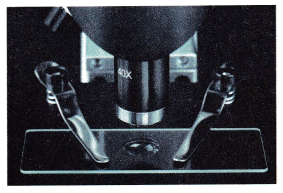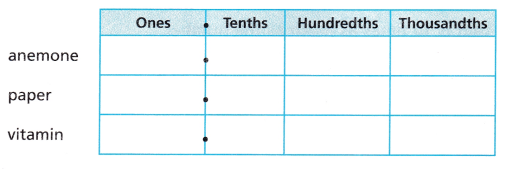We included HMH Into Math Grade 5 Answer Key PDF Module 13 Lesson 1 Understand Thousandths to make students experts in learning maths.
HMH Into Math Grade 5 Module 13 Lesson 1 Answer Key Understand Thousandths
I Can describe the relationship between two decimal place-value positions to the thousandth place.
Spark Your Learning
Kiana is looking at seawater under a microscope to search for microscopic organisms. A droplet of seawater has a mass of about 51.3 milligrams.

What would be the mass of 10 droplets of seawater? Show your reasoning.

Answer:
Given that,
The mass of the droplet of seawater is 51.3 milligrams.
The mass of 10 droplets of seawater is 51.3 x 10 is 513 milligrams.
Turn and Talk Kiana puts 10 droplets of freshwater in a test tube. The droplets have a mass of about 499.0 milligrams. What would you expect the mass of one droplet of freshwater to be? How do you know?
Answer:
Given that,
The mass of the 10 droplets of freshwater is 499.0 milligrams.
The mass of one droplet of freshwater is 499.0/10 = 49.9.
Therefore the mass of one droplet is 49.9 milligrams.
Build Understanding
Question 1.
DeShawn measures the length of a phytoplankton under a microscope as 0.1 mm. Use the place-value chart to answer the questions.

A. Which part of the chart represents the length of the phytoplankton? How do you know?
Answer:
B. Which part of the chart represents the length of an organism that measures 10 times as much as the length of the phytoplankton? How do you know?
Answer:
C. Which part of the chart represents the length of an organism that measures ~ of the length of the phytoplankton? How do you know?
Answer:
D. How could you represent thousandths in the chart?
Answer:
Connect to Vocabulary
A thousandth is one of one thousand equal parts.
Example:
0.008 = eight thousandths
Question 2.
The length of a sea creature, the anemone, measures 0.04 inch early in its development. It is about 10 times as thick as a sheet of paper and \(\frac{1}{10}\) of the width of a vitamin.

A. Use the place-value chart to represent each measure.

B. What patterns in the chart can you describe?
C. What are the measures of the three items?
Answer:

The pattern in the chart shows that the anemone is 0.04 inch, the thickness of paper is 0.4 inches and the width of a vitamin is 0.004 inch.
So, the measure of the three items is 0.04, 0.4, 0.004 inch.
Turn and Talk How do the place-value positions with decimals compare to the place-value positions with whole numbers?
Check Understanding
Question 1.
Ten pennies weigh about 0.9 ounce. About how much does one penny weigh?
Answer:
Given that,
10 pennies weigh = 0.9 ounce.
1 penny weigh = 0.9/10 = 0.009.
Therefore 1 penny weigh = 0.009 ounce.
Question 2.
One dime weighs about 0.005 pound. About how much do 10 dimes weigh?
Answer:
Given that,
1 dime weighs = 0.005 pound.
10 dimes weigh = 0.005 x 10 = 0.05 pound.
Therefore 10 dimes weigh is 0.05 pounds.
On Your Own
Question 3.
Use Tools Complete the table to write numbers that are 10 times as much as, and \(\frac{1}{10}\) of, 0.5.

Answer:
Given that,
The number is 0.5
10 times of 0.5 is 0.05

Write the number that is 10 times as much as the number.
Question 4.
0.002
Answer:
Given that the number is 0.002.
10 times of 0.002 is 0.002 x 1/10 is 0.0002.
Therefore 10 times the 0.002 is 0.0002.
Question 5.
8.739
Answer:
Given that the number is 8.739.
10 times of 8.739 is 8.739 x 1/10 is 0.8739.
Therefore 10 times the 8.739 is 0.8739.
Question 6.
35.4
Answer:
Given that the number is 35.4.
10 times of 35.4 is 35.4 x 1/10 is 3.54.
Therefore 10 times the 35.4 is 3.54.
Write the number that is \(\frac{1}{10}\) of the number.
Question 7.
0.25
Answer:
Given that,
The number is 0.25.
Therefore 0.25 x \(\frac {1}{10} \) is 0.025.
Question 8.
5,019.72
Answer:
Given that,
The number is 5,019.72
Therefore 5019.72 x \(\frac {1}{10} \) is 501.972.
Question 9.
3.6
Answer:
Given that,
The number is 3.6
Therefore 3.6 x \(\frac {1}{10} \) is 0.36.
Question 10.
Reason Five-hundredths multiplied by what number is five thousandths? Explain.
Answer:
500 x 10 = 5000.
500 multiplied by 10 is 5000.
Therefore five-hundredths multiplied by ten is five thousandths.
Question 11.
Use Structure In the number 9.689, how does the value of the digit 9 to the left of the decimal point compare to the value of the digit 9 to the right of the decimal point?
Answer:
Given that,
The number is 9.689
One 9 is the left side of the decimal and the other 9 is the right of the decimal.
The first digit after the decimal represents the tenth place. So, the 9 on the left side is in the thousands place so it can be written as 1/1000.
The first digit before the decimal is one’s place. so it can be written as 9.
I’m in a Learning Mindset!
What do I do when I’m learning something new? What helps me remember what to do?